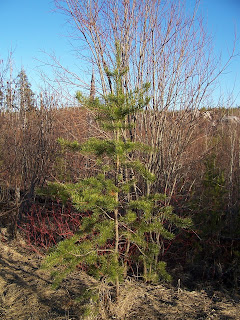Yesterday, I decided to take a hike up to the old Gunflint Fire Tower site. It is located on a spur of the Kekekabic Trail, which can be accessed from the trail-head on the Gunflint Trail.
From the Gunflint Lake Overlook parking lot, drive towards the end of the Gunflint Trail. You will pass the South Gunflint Lake Road, North Gunflint Lake Road, and Gunflint Narrows Road on your right. Then you will pass the Round Lake Road on your left. A very short distance after the Round Lake Road, you will find the Kekekabic Trail parking lot on your left. If you come to the Magnetic Rock Trail parking lot on the right, you have gone about 100 yards too far.
According to the Centennial Trail interpretive brochure, the Kekekabic Trail was built in the mid 1930's to give firefighters access to the remote areas of the wilderness. It stretches 40 miles from the Gunflint Trail to Ely, Minnesota. The three biggest fires in the last several decades have crossed this path including: the Cavity Lake Fire of 2006, the Ham Lake Fire of 2007, and the Pagami Creek Fire of 2011.

On the way to the tower sight, I saw many wonders of nature, including the Jack Pine cone on the right. It was so spectacular in the drab colors of early spring that I had to stop and take a picture. If you want to see pictures of the other two types of pine cones in the area, see my recent Red Pine, Jack Pine, and White Pine article.
The plant on the left is called a Ground Pine, or Princess Pine. It is a member of the Clubmoss (Lycopodiaceae) Family. Fossil evidence suggests that this family of plants was around in the Jurassic Period, about 150,000,000 years ago. At that time, it was about 100 feet tall. The biggest ones I see now are about 8 inches tall.
These plants are more advanced than moss in that they are a vascular plant. However, they are less advanced than pines because they reproduce by spores, and they don't have a true root system. The spores are produced in the thin yellow area on top of the plant, and make a great flash powder for stage explosions.


These next two pictures are of Haircap Mosses (Polytrichum spp.) Moss must have water flow over it to reproduce. That is one of the reasons they are so short.
The picture on the right is of a combination of mosses and lichens. This is a good time of year to see all these evergreen plants, because they are covered by snow in the winter, and larger, leafy plants in the summer.
The trail up to the fire tower site is deceivingly long the first time you ascend it. From the junction with the Kekekabic Trail, it looks like just a short hill to climb to the top. However, when you get to the top of that hill, there is another hill, and when you get to the top of the next rise, you find the climb continues until you take a turn to the west near the top, and come to the sight of the fire tower.
The first thing you come upon is the foundation of the old house used by the people who worked in the tower. It is hard to get a picture of the entire foundation, but walking around it, there were multiple rooms, and 1 or 2 fireplaces.
A few steps beyond the house foundation is the ruins of the cab (top) of the tower. It is partially crushed, but still surviving. Image what it was like to stand in this cab when it was raised high in the sky looking for forest fires.
If a fire was spotted, you took a directional reading from the tower, and reported it to headquarters. They would look on a map, and draw a line from your tower in the direction of the fire. As other towers called in, they would draw the lines from their towers on the map as well. The spot where the lines from at least 3 towers intersected was the location of the fire.

The trail up to this spot was obscured after the windstorm on July 4, 1999, and not opened again until 2005. At the time of the Alpine Lake Fire, communications personnel from the U.S. Forest Service opened the trail to place communications equipment in one of the highest places around (2064 feet).

It is worth noting that the lowest point in Minnesota is the shore of Lake Superior (602 feet above sea level), and the highest point is Eagle Mountain (2,301 feet above sea level). They are both in Cook County.
This is one of the few spots in the
area that offers 360 degree views.
These 6 pictures show the 360

degree views from the high spot next to the fallen tower. Gunflint Lake can be seen in the top left, and bottom right picture. Imagine what the view must have been like from the top of the tower when it was standing.
The rocks that the tower sits upon are Ely Greenstone. They are ancient metamorphosed pillow basalt that were formed approximately 2,600,000,000 years ago. Long ago, magma from a volcano flowed into water and formed the pillow basalt. Some time later, those rocks were metamorphosed (transformed) by heat and/or pressure into the Ely Greenstone you see today. This formation contains the oldest rocks in the area, and extends from Ely, Minnesota to the Gunflint Lookout Tower site.



















































